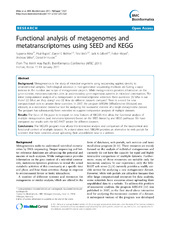Functional analysis of metagenomes and metatranscriptomes using SEED and KEGG
Mitra, Suparna; Rupek, Paul; Richter, Daniel C.; Urich, Tim; Gilbert, Jack A.; Meyer, Folker; Wilke, Andreas; Huson, Daniel H.
Peer reviewed, Journal article
Published version
Permanent lenke
https://hdl.handle.net/1956/5500Utgivelsesdato
2011-02-15Metadata
Vis full innførselSamlinger
Originalversjon
https://doi.org/10.1186/1471-2105-12-s1-s21Sammendrag
Background: Metagenomics is the study of microbial organisms using sequencing applied directly to environmental samples. Technological advances in next-generation sequencing methods are fueling a rapid increase in the number and scope of metagenome projects. While metagenomics provides information on the gene content, metatranscriptomics aims at understanding gene expression patterns in microbial communities. The initial computational analysis of a metagenome or metatranscriptome addresses three questions: (1) Who is out there? (2) What are they doing? and (3) How do different datasets compare? There is a need for new computational tools to answer these questions. In 2007, the program MEGAN (MEtaGenome ANalyzer) was released, as a standalone interactive tool for analyzing the taxonomic content of a single metagenome dataset. The program has subsequently been extended to support comparative analyses of multiple datasets. Results: The focus of this paper is to report on new features of MEGAN that allow the functional analysis of multiple metagenomes (and metatranscriptomes) based on the SEED hierarchy and KEGG pathways. We have compared our results with the MG-RAST service for different datasets. Conclusions: The MEGAN program now allows the interactive analysis and comparison of the taxonomical and functional content of multiple datasets. As a stand-alone tool, MEGAN provides an alternative to web portals for scientists that have concerns about uploading their unpublished data to a website.

